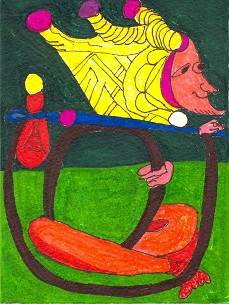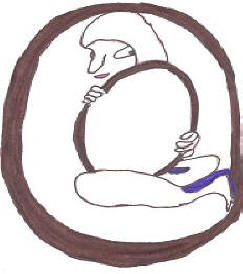rtreview.org
Arts―Humanities―Social
Sciences
About the rtreview
Logo
The rtreview.org Logo is a variation on the Nicolas Conver (circa 1760) Marseilles style Fool Trump head attached below to an image of hoops of knowledge and self-reflection.
Usually the Fool may signify aimless wandering and seeking of what is yet unknown. It can also represents madness or whimsy or hidden wisdom.
The bottom half of the image symbolizes hoops of knowledge in a mirror of reflection within reflection.
Here this mirror embodies a pause in the searching, wandering of the Fool to be still and contemplate what it has found. This pause is distracted as the fool’s goal is usually otherwhere, a sniffing toward transcendence.
About the
Scriptable Logo
The Scriptable Logo emphasizes a coy reflecting from within the hermeneutic circle upon the hermeneutic circle. The profile face personifies curiosity and wonder. She maybe looking at the viewer or at herself in the hoop mirror she holds.
She sits cross-legged to express contentment in containment, but the lemniscate shape [∞] of the crossed legs suggests a hankering for anchoring.
This single-eyed gaze may not be just between subject or object, but into transparencies of the reflective processes. This gazing into the emptiness of gazing epitomizes a method of self-conscious hermeneutics embodied in the essays of Scriptable, where the subject as object and the object as subject becomes invisible and open to unexpected transformation. This logo represents how Scriptable handles its consideration of the books under review.
***
Both Logos represent inquiry as play and analysis. It is the essay as high seriousness in search of truth.
We assume the essay or review exists between the poetic [as playful and creative] and the historic as storytelling narrative and factual examination. This represents focus of the essays in Scriptable.
Aristotle viewed poetry as superior to history because poetry is characterized by qualities of higher truth and higher seriousness. Matthew Arnold in his epochal essay The Study of Poetry attributed the quality of high seriousness to great poetry. From Arnold’s essay we may surmise that “high seriousness” is involved with reflections upon the bleakly real such as the tragic attributes of living. Arnold’s gives instances from Dante, Shakespeare and Milton’s poetry which contains a sustained magnificence of artistic conception and execution combined with a multilayered conscience and mystical ideals.
Logos

rtreview Logo

Scriptable Logo